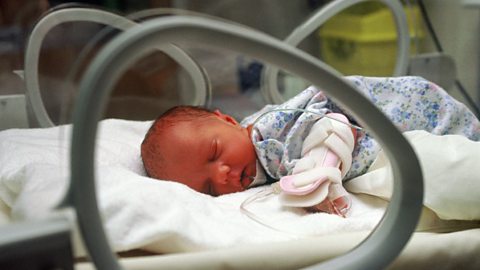Fetal development and birth
Fetal development
Fertilisation happens when an egg cell meets with a sperm cell and joins with it. The fertilised egg divides to form a ball of cells called an embryoAn organism in the early stages of development.. The embryo attaches to the lining of the uterus. It begins to develop into a fetus (foetus)An unborn baby. Usually eight weeks after conception. and finally into a baby.
Development of the fetus
The fetus relies upon its mother as it develops. These are some of the things it needs:
- protection against knock and bumps, and temperature changes
- oxygen for respiration
- nutrients (food and water)
The developing fetus also needs its waste substances removing.
The fetus is protected by the uterus and the amniotic fluidLiquid that protects the fetus in the uterus., a liquid contained in a bag called the amnionBag surrounding the foetus in the uterus and containing the amniotic fluid..
The placenta
The placentaThe organ in the uterus of pregnant mammals that allows the transfer of nutrients and waste products between the mother and the fetus through the umbilical cord. is an organ responsible for providing oxygen and nutrients, and removing waste substances. It grows into the wall of the uterus and is joined to the fetus by the umbilical cordThe cord that connects the foetus to the placenta. It contains blood vessels..
The mother's blood does not mix with the blood of the fetus, but the placenta lets substances pass between the two blood supplies:
- oxygen and nutrients diffuseWhen particles spread out from a region of higher concentration to a region of lower concentration. across the placenta from the mother to the fetus
- carbon dioxide and other waste substances diffuse across the placenta from the fetus to the mother
The mother’s lifestyle can affect the developing fetus. For example, smoking reduces the amount of oxygen in the bloodstream. This can lead to low birth weight and premature birth (when a baby is born too soon). Drinking alcohol during pregnancy can harm the developing baby’s nervous system, especially its brain.
Birth
It takes about 40 weeks for a baby to develop in the uterus. This time is called gestationThe time during which a fertilised egg develops into a baby ready to be born.. After this, the baby is ready to be born. The cervix relaxes and muscles in the wall of the uterus contract. Waves of muscle contraction push the baby out of the mother's body through the vagina.
